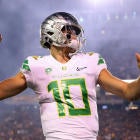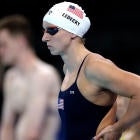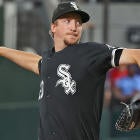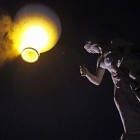Justin Herbert was likely going to be the first quarterback selected in the 2019 NFL Draft, but he was far from a finished product, drifted into "overrated" territory as a prospect, and made the correct decision to return for his senior season at Oregon. That weakens the options for QB-needy teams, but here are the guys worth knowing who could be first-round picks in April.
Asking how Herbert can improve his draft stock -- and, more importantly, his chances of long-term success at the NFL level -- is a logical question to pose at this juncture. Despite the hype surrounding him, Herbert is still raw in two paramount areas of playing the quarterback position.
If he sharpens his skills in these two areas, Herbert's choice to stay in school for another season will be viewed in a similar vein to that of Andrew Luck, who returned to Stanford in 2011 after a dazzling redshirt sophomore year and despite massive draft buzz, then went No. 1 overall in 2012, instead of other quarterbacks who flopped in their highly anticipated final collegiate campaigns and ultimately sank in the draft.
Pocket management
I value pocket management as the second-most important quarterback attribute (behind accuracy). Pocket management separates great quarterbacks from good ones. Also, excellent pocket management from a quarterback masks offensive-line deficiencies. Drew Brees, Aaron Rodgers, Tom Brady, Philip Rivers, Matt Ryan, Ben Roethlisberger, and Luck excel maneuvering away from pressure and making accurate throws to all levels of the field.
Early in the season, Herbert routinely left clean pockets or, at times, morphed into a running back (with his eyes dropping) inside the pocket after the first few reads were unavailable. I'm not sure which is worse, but both are major red flags for a quarterback prospect, especially if they occur often. In season-opening wins against Bowling Green, Portland State, and San Jose State, his pocket management was consistently disappointing.
However, against Stanford -- Oregon's fourth game -- Herbert was a wizard drifting away from pressure, keeping his eyes up, and throwing with plus ball-placement while technically under pressure.
Against Cal, Washington's talented secondary, and in the first half against Washington State, Herbert had moments of stellar pocket management before firing accurate rockets but also moved into pressure or left undisturbed pockets.
In the second half against Washington State, when the Ducks erased a 27-0 halftime deficit to make it 27-20 with under seven minutes to go in the fourth quarter, Herbert was Luck-esque, subtly moving in the pocket as defenders flew past him. In those final two games on the road, he was more locked in than any other quarterback I evaluated this season.
Deep-ball accuracy
While the NFL has become a West Coast offense league, where the quick passing game is king, the creation of explosive plays by way of the deep ball still has value.
And for someone like Herbert with a big arm, the team that ultimately drafts him will want to be able to accentuate his arm strength by stretching the field somewhat often. Asking him to solely dink and dunk wouldn't be tapping into his full skill set.
After Herbert's hit-or-miss pocket management, the most glaring weakness I noticed game by game was his deep-ball touch. Below are the figures to back up that observation.
Per Sports Info Solutions, Herbert connected on just seven of 26 passes made 30 or more yards downfield in 2018. Of those passes, 11 were considered "on-target," which equates to an on-target percentage of 42.3 percent. So, how bad is that? Well, here are the on-target percentages on downfield throws of the same length from other prominent college quarterbacks this season:
- Tua Tagovailoa: 70.6%
- Drew Lock: 69.2%
- Will Grier: 69%
- Dwayne Haskins: 69%
- Kyler Murray: 68.8%
- Daniel Jones: 65%
- Jake Browning: 64.7%
- Ryan Finley: 54.5%
- Gardner Minshew: 52.2%
Herbert even regressed himself in this area from 2017, when he completed 40 percent of his throws made at least 30 yards down the field and had an on-target percentage of 52.0 percent.
While Herbert thrived throwing aggressively down the seam and while on the run, he simply was not very accurate deep in 2018. Sure, most offensive coordinators won't see that as a huge negative because of the yards-after-the-catch predicated state of most passing schemes today.
But defenses have to be stretched from time to time, and Herbert needs to improve in that area to be able to, at the very least, keep defenses honest.
Why his decision makes sense
At 6-foot-6 and over 230 pounds with what I've called a "live arm" all season to go along with loads of athleticism, Herbert has the tools to be a Luck-type prospect in the 2020 draft. He typically makes good decisions, is almost always accurate at the short and intermediate levels, flashed the ability to make anticipation throws (especially toward the sideline), and isn't tentative when throwing through tight windows (particularly on the run).
But he needs to own the pocket next season at Oregon. Pass-rushers can't faze him. College quarterbacks can get better in that area with more experience, which is the main reason I love his decision to return to school. After that, Herbert needs to sharpen his downfield accuracy so his big arm will be a useful part of his overall game. If he improves in those two areas, while maintaining his current strengths, he'll essentially be a lock to go No. 1 overall in the 2020 draft.

















